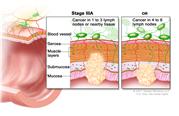The search textbox has an autosuggest feature. When you enter three or more characters,
a list of up to 10 suggestions will popup under the textbox. Use the arrow keys
to move through the suggestions. To select a suggestion, hit the enter key. Using
the escape key closes the listbox and puts you back at the textbox. The radio buttons
allow you to toggle between having all search items start with or contain the text
you entered in the search box.

 (...KOH-loh-REK-tul KAN-ser)
(...KOH-loh-REK-tul KAN-ser)

|
|
Stage III colorectal cancer is divided into stage IIIA, stage IIIB, and stage IIIC. In stage IIIA, (1) cancer may have spread through the mucosa (innermost layer) of the colon and/or rectal wall to the submucosa (layer of tissue under the mucosa) and may have spread to the muscle layer of the colon and/or rectal wall. Cancer has spread to at least one but not more than 3 nearby lymph nodes, or cancer cells have formed in tissues near the lymph nodes; or (2) cancer has spread through the mucosa of the colon and/or rectal wall to the submucosa. Cancer has spread to at least 4 but not more than 6 nearby lymph nodes.
In stage IIIB, (1) cancer has spread through the muscle layer of the colon and/or rectal wall to the serosa (outermost layer) of the colon and/or rectal wall or has spread through the serosa but not to nearby organs. Cancer has spread to at least one but not more than 3 nearby lymph nodes, or cancer cells have formed in tissues near the lymph nodes; or (2) cancer has spread to the muscle layer of the colon and/or rectal wall or to the serosa of the colon and/or rectal wall. Cancer has spread to at least 4 but not more than 6 nearby lymph nodes; or (3) cancer has spread through the mucosa of the colon and/or rectal wall to the submucosa and may have spread to the muscle layer of the colon and/or rectal wall. Cancer has spread to 7 or more nearby lymph nodes. In stage IIIC, (1) cancer has spread through the serosa of the colon and/or rectal wall but has not spread to nearby organs. Cancer has spread to at least 4 but not more than 6 nearby lymph nodes; or (2) cancer has spread through the muscle layer of the colon and/or rectal wall to the serosa of the colon and/or rectal wall or has spread through the serosa but has not spread to nearby organs. Cancer has spread to 7 or more nearby lymph nodes; or (3) cancer has spread through the serosa of the colon and/or rectal wall and has spread to nearby organs. Cancer has spread to one or more nearby lymph nodes, or cancer cells have formed in tissues near the lymph nodes. Also called Dukes C colorectal cancer.
|







